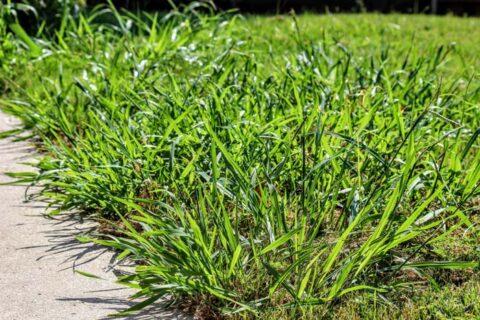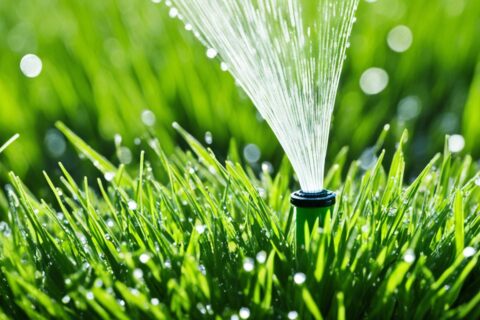4 ways to get your lawn ready for spring: part 2

Are you ready to have the best looking lawn in your neighborhood? It all starts with the right approach. In part one of our two-part series, we described the importance of spring cleanups and power raking (if needed). In this blog, we describe why it’s absolutely crucial to suppress crabgrass before it germinates and the importance of proper fertilization. Following these steps is the first step in growing beautiful, healthy turf.
1. Prepare for the Crabgrass Invasion
Take a quick look at your lawn. Do you see bare spots? How about thin areas? Trust us when we say that’s cause for concern; there’s high probability crabgrass fills in these areas. And once established, this weed is difficult—and often expensive—to eradicate, let alone manage.
Crabgrass is an annual weed that easily outcompetes cool-season grasses, such as Kentucky Blue, Rye, and Fescue. Crabgrass seeds begin to germinate when soil temperatures reach 55 degrees or above for roughly five consecutive days. A single crabgrass plant is capable of growing upwards of 700 tillers and producing 150,000 seeds during its lifecycle.
Crabgrass is difficult to manage for multiple reasons:
- It can grow in almost any turf and landscape environment.
- As a warm-season plant, it thrives in dry, sunny, hot climates. Cool-season grasses typically go dormant or struggle in these conditions.
- It can survive low mowing (under 2 inches). Cool-season grasses should be mowed between 3.5 and 4 inches year-round.
- It can withstand tremendous stress caused by foot traffic or machinery. Most cool-season grasses are much less likely to recover if repeatedly pummeled by foot traffic or machinery.
Any successful lawn care plan includes a strategy to manage crabgrass germination and establishment. For more on how to control crabgrass, check out our previous blog, “Control Crabgrass This Spring and Grow a Beautiful Lawn.”
2. Feed Your Lawn
For turf to grow deep roots and strong blades, it’s critical to provide it with the proper amount and type of nutrients. Fortunately, many of the 18 required nutrients are already readily present in most soil. (The exception is unusual soil types, such as ones that are very sandy, acidic, or alkaline.) As a result, we only have to worry about providing already-established lawns with the required amount of two macronutrients (nitrogen and potassium), which are typically not present in the soil in large enough quantities.
If growing a new lawn, we do recommend applying fertilizer that contains phosphorus because it stimulates early root growth—something that’s just as (if not more important) than blade development at this stage in the turf’s life. However, Massachusetts regulates how and when phosphorus is used, so it’s important to follow proper protocols.
But there’s more! While it’s important to consider the amount of fertilizer used, we must also consider the type of product and when it’s applied.
GreenAce Lawn Care only uses what’s called slow-release fertilizer (not quick-release fertilizer). Unlike quick release, which has a propensity to quickly leach from soil and pollute waterways, slow-release fertilizer can last upwards of six to eight weeks. Because turf only extracts nutrients when needed, slow-release fertilizer almost always provides a more uniform turf establishment. And it’s also less likely to burn lawns.
3. Bonus Tip: Develop a Plan and Stick With It
Overwhelmed by the thought of having to care for your lawn and landscape all by yourself? We understand: It’s a lot of work. However, this tall task is made easier when you establish a long-term lawn and landscape plan and stick with it.
In a previous blog, we described how to review (and overhaul, if needed) your current lawn care strategy. Here are highlights:
- Create a List: List the different ways you currently take care of your lawn and landscape. Describe how high you mow the lawn and the frequency. Jot down how often you water your turf and the amount you apply. And note the frequency and timing of fertilizer applications, to name a few.
- Embrace Change: Accept that your plan is really more like an outline. Almost always, how you treat your lawn in the spring differs from how you treat it in the summer, fall, and certainly winter.
- Call a Professional: This may seem like an advertising plug (OK, it is a little), but professionals are here to help you maintain and grow healthy turf. We take on much of the heavy lifting.
- Don’t Aerate or Dethatch: A quick Google search will reveal a plethora of articles written by “lawn care professionals” stating that it’s a good idea to aerate and dethatch turf in the spring. However, that’s simply fake news. For more on why you should only perform these procedures in the fall, check out our blog “4 Things You Should Never Do to Your Lawn in the Spring.”
We service many towns in Norfolk County, Mass. including Foxborough, Mansfield, Sharon, Walpole, Norwood, Westwood, Norfolk, Medway, Millis, Medfield, Dover, Sherborn, and surrounding towns. For more information, contact us today.
Your trusted lawn care provider and lawn pest exterminator
We Service Areas of Norfolk and Bristol County, Massachusetts Including, Foxborough, Mansfield, Wrentham, Walpole, Plainville, Franklin, Norfolk, Sharon, North Attleborough, and Parts of Attleboro, Stoughton, Canton, Norwood, Norton and Medfield. Learn more about our Complete Lawn Care program.


